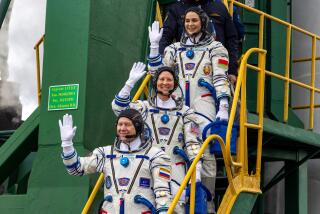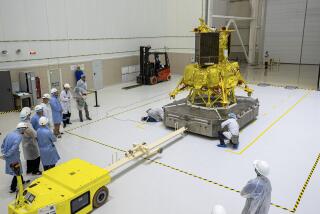Soviets Launch 2nd Rocket to Mars Moon
- Share via
MOSCOW — The Soviet Union fired off a second Mars rocket Tuesday night as flawlessly as they did the first one five days earlier, but it left scientists here with a nagging question:
Will luck still be riding with them about 200 days and 110 million miles from now, when the two spacecraft will be called on to perform a series of experiments?
“We hope so,” Lev Mukhin, one of the key scientists in the Soviet Mars program, said. “But nobody knows. . . .”
The results could have a profound impact on the Soviet space program. If this mission succeeds, it will put the first man-made devices on the surface of another celestial body in more than a decade, and the world will get to watch as a tiny toy-like instrument hops around the surface of the Martian moon of Phobos. The moon was chosen as an initial target in an ambitious Soviet project for an eventual manned mission to Mars.
Because of growing openness in the Soviet space program, the Phobos mission will be acted out on center stage, making this a high-stakes game among various competing factions in the Soviet scientific community.
A European scientist who has been associated with the Soviet program for more than two decades noted that after a string of disastrous attempts to put instruments on Mars in the early 1970s, the Soviet planetary program was virtually dead for 15 years. If they fail now, with the world watching, the scientist said, it could cripple an ambitious program that is aimed at landing humans on Mars by the year 2010.
It is planned for the two Soviet spacecraft to carry out numerous experiments developed by scientists from 13 countries--a record number of international participants in any space mission--during the long voyage. Each spacecraft carries two landers the Soviets hope to put on the surface of Phobos, an irregularly shaped black moon that is so small that its gravity is almost immeasurable.
If the effort is to succeed, Soviet scientists at mission control here must continuously know the position of the spacecraft within a few hundred yards, a level of perfection that has not been required on any previous mission by any country, according to scientists working on the project.
The Soviets have doubled the odds in their favor by sending two spacecraft to do the job. The two are nearly identical, and if one fails, the other should be able to carry on.
More to Read
Sign up for Essential California
The most important California stories and recommendations in your inbox every morning.
You may occasionally receive promotional content from the Los Angeles Times.









